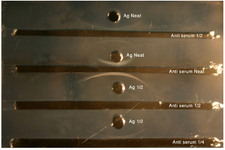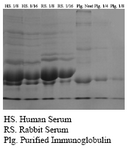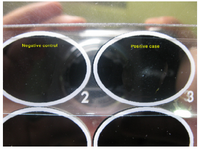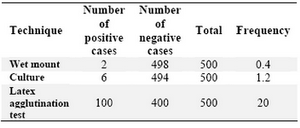Development of a Latex Agglutination Test as a Simple and Rapid Method for Diagnosis of Trichomonas vaginalis Infection
-
 Yousofi Darani, Hossein
Ph.D., Department of Parasitology and Mycology, Faculty of Medicine, Shahrekord University of Medical Sciences, Shahrekord, Iran, Tel: 0098 381 3332707, Fax: 0098 381 2221669, E-mail: H_yousofi@yahoo.com Yousefi@skums.ac.ir
Yousofi Darani, Hossein
Ph.D., Department of Parasitology and Mycology, Faculty of Medicine, Shahrekord University of Medical Sciences, Shahrekord, Iran, Tel: 0098 381 3332707, Fax: 0098 381 2221669, E-mail: H_yousofi@yahoo.com Yousefi@skums.ac.ir
-
Department of Parasitology, Cell and Molecular Research Center, Faculty of Medicine, Shahrekord University of Medical Sciences , Shahrekord, Iran
-
Ahmadi, Firuzeh
-
Department of Parasitology, Shahrekord University of Medical Sciences , Shahrekord, Iran
-
Zabardast, Nozhat
-
Department of Parasitology, Shahrekord University of Medical Sciences , Shahrekord, Iran
-
Yousefi, Hossein Ali
-
Department of Parasitology, Isfahan University of Medical Sciences , Isfahan, Iran
-
Shirzad, Hedayat
-
Department of Immunology, Faculty of Medicine, Shahrekord University of Medical Sciences , Shahrekord, Iran
Abstract: Trichomoniasis is a worldwide infection and due to its complications rapid and accurate diagnosis of infection especially in pregnant women is very important. In this study, development of a latex agglutination test using native antigens for rapid diagnosis of trichomoniasis is investigated. Trichomonas vaginalis was harvested from TYIS33 culture medium and anti Trichomonas vaginalis antiserum was raised in rabbits. Salt precipitation method was used for antibody purification. Polyesteren latex particles coated with purified antibody and used for detection of Trichomonas vaginalis. Clinical samples of vaginal discharge were collected from 500 women and examined for Trichomonas vaginalis by using wet mount, culture and latex agglutination tests. Sensitivity and specificity of latex test was determined considering culture as golden standard. Sensitivity and specificity of latex agglutination test was 100% and 81% and those of wet mount were 33.3% and 100%, respectively. Positive and negative predictive values of latex agglutination test were 6% and 100%, respectively. Due to inconvenient sensitivity and specificity of the latex agglutination test developed in this study, further work is recommended to improve the test.
Introduction :
Trichomoniasis is a worldwide infection with variant prevalence in different countries (1 - 4). Due to complications of the disease rapid and accurate diagnosis of infection especially in pregnant women is very important. Wet mount method is usually used for routine field diagnosis (5 - 7).
This technique is specific but its sensitivity is not appropriate (6 - 8). Culture is another parasitological method with relatively suitable sensitivity and specificity.However, the procedure is time consuming and also is not available in all field laboratories. Therefore, it is necessary to
investigate on a simple and rapid diagnosis test with acceptable sensitivity and specificity.
Latex agglutination test has been used in several studies and it has been shown that it has a high sensitivity and specificity and now is used as a routine diagnosis test in some countries (9, 10). In this study, development of a latex agglutination test using native antigens for rapid diagnosis of trichomoniasis is investigated.
Materials and Methods :
Clinical samples of vaginal discharge were collected with informed consent from 500 women referred to genital clinic of Shahrekord University of Medical Sciences in Shahrekord, Iran. For every individual three vaginal swaps were collected.The first swap was used for wet mount examination, the second one for culture in TYIS33 medium and the third was immersed in glycine buffer and kept in -20 ?C and then used for latex agglutination test.
When medium culture was full of active Trichomonas vaginalis it spanned at 2000g for 2 min. The parasite pellet was given two washes with saline and the final sediment resuspended in 1 ml saline and mixed with Freund’s adjuvant. Rabbit anti Trichomonas vaginalis antiserum was raised as described before (11).
Salt precipitation method was used for antibody purification. In this technique 5 ml of saturated ammonium sulfate was gently added to 10 ml rabbit antiserum and mixed in a magnetic stirrer for 1 hr. The mixture was centrifuged at 3000g for 30 min. Supernatant was discarded and the sedimentation mixed in 10 ml distilled water and given two washes. Phosphate buffer saline (PBS) was added to the final sediment up to 10 ml. The mixture was then dialyzed to remove the access salt and stored at -20 ?C until needed.
Immunoelectrophoresis (IEP) and SDS-PAGE was performed as described before (12, 13). Polyesteren beads particles (SIGMA) were conjugated with antibodies as described by V. Hopwood et al (14).To determine sensitivity and specificity of the latex agglutination, positive results in culture method was considered as golden standard.
Result :
Production of rabbit antiserum against Trichomonas vaginalis parasite was confirmed in immunoelectrophoresis (Figure 1). Purification of antibodies from rabbit antiserum was demonstrated in SDS- PAGE (Figure 2). To demonstrate efficacy of developed latex agglutination kit in detection of Trichomonas vaginalis antigens, parasite was harvested from culture medium and prepared in different concentrations including 100-1000 parasites per ml in glycine buffer. In a black latex agglutination slide one drop of buffer containing antigen was mixed with one drop of polysteren coated antibody.
Slide was left in a shaker for 5 min and then observed for agglutination. This test was then repeated with different concentration of antigen (buffer containing Trichomonas vaginalis) and antibody (polysteren coated immunoglobulin) to find the appropriate concentration which yields the best agglutination (Figure 3).
Frequency of Trichomonas vaginalis infection among 500 women was 0.4% with wet mount test, 1.2% with culture method and 20% with latex agglutination technique (Table 1).Sensitivity and specificity of wet mount and latex agglutination test in detection of infection in comparison with culture method as golden standard is shown in table 2.
Discussion :
In this work, a latex agglutination test was developed as a simple and rapid method for diagnosis of Trichomonas vaginalis infection. Sensitivity and specificity of this test based on culture method as golden standard in vaginal discharge of 500 women was 100% and 81%, respectively.
Carney et al in 1988 compared different tests for diagnosis of Trichomonas vaginalis infection. They determined sensitivity of 95.2% and specificity of 99.4% for latex agglutination test. They also showed positive predictive value of 95.2% and negative predictive value of 99.4% for the test (10).
Audo Sarkoudiey et al in 2004, also used combination of positive results of culture and wet mount as golden standard. According to their results sensitivity and specificity of latex agglutination test was 98.8% and 92.1%, respectively. Positive and negative predictive values for this test were 83% and 99.5%, respectively (9). In another investigation,Lopez Abraham et al showed a sensitivity of 97.7% and an efficacy of 97.5% (15) and Fernandez et al showed sensitivity of 86.7% and specificity of 95.1% for latex agglutination test in detection of Trichomonas vaginalis in vaginal discharges (16).
Sensitivity, specificity, positive and negative predictive values of the latex agglutination kit developed in this study is not convenient enough to be used in routine field diagnosis. One reason for this inconveniency may be due to the fact that Hajar hospital clinic is a referral clinic in Shahrekord. Therefore, women before attending this clinic may be subjected to different treatment for vaginal infections such as metronidazole and these therapeutic agents may interfere with the results of wet mount and culture methods for detection of Trichomonas vaginalis. Another reason for inconvenient sensitivity and specificity of the latex agglutination kit may be related to technical issues such as immunoglobulin purification or polysteren coating with antibodies. Therefore, further work is recommended to solve the problem.
Acknowledgement :
This work was supported by grant from Shahrekord University of Medical Sciences.

Figure 1. Immunoelectrophoresis of Trichomonas vaginalis sonicated antigen (wells) probed with rabbit antisera raised against parasite (troughs)
|

Figure 2. SDS-PAGE of whole rabbit serum in comparison with purified immunoglobulin
|

Figure 3. Latex agglutination of Trichomonas vaginalis harvested from culture medium and ploysteren coated purified antibody in comparison with negative control
|

Table 1. Frequency of Trichomonas vaginalis infection among 500 examined women according to wet mount, culture and latex agglutination test developed in this study
|

Table 2. Sensitivity, specificity, positive predictive value and negative predictive value of wet mount and latex agglutination test in detection of Trichomonas vaginalis infection in comparison with culture method as golden standard
|
|